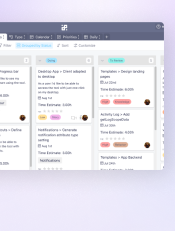How to Set Smart, Measurable Product Goals
Product goals are the highest-level objectives regarding the product — the big, bold ideas for your product and business in the future. These goals should be the crucial achievements that need to happen to turn your vision into reality.
By always keeping product goals in front of you and your team, you will make it much easier to focus on what needs to be done and when.
Although product goals are abstract, they should derive from KPIs. In other words, they should be measurable and achievable within a certain timeframe.
How to Set SMART Goals
Setting goals might turn out more challenging than you expect. The SMART methodology provides one of the best guidelines for coming up with the right goals and for defining them the right way.
Here’s what the acronym SMART stands for:
S = specific, significant, stretching
M = measurable, meaningful, motivational
A = agreed upon, attainable, achievable, acceptable, action-oriented
R = realistic, relevant, reasonable, rewarding, results-oriented
T = time-based, time-bound, timely, tangible, trackable
Aside from creating SMART goals, you’ll need to ensure they are aligned with your overall product strategy and business strategy.
Here are a few examples of high-level product goals that will help you drive your product forward:
- Become #1 work and data management platform by 2025
- Become a $1 billion company by January 2024
- Develop an exceptionally secure and trustworthy application by 2023
- Reach 1 million users by Q1 2025
Setting Product Goals in Infinity
The goals you set will determine the direction of your product and drive the smaller, short-term goals and actions necessary for the strategy execution. You can set the goals in a separate folder where stakeholders can keep an eye on them, and give editing access only to the product owner and product manager.
Setting product goals using Infinity is pretty easy with the help of our Product Management template. All you need to do is follow these steps:
- Step 1: Open the Goals subfolder in the Product Strategy folder.
- Step 2: Delete all sample goals, or leave one goal to use as a template and delete everything else.
- Step 3: Add a new item by clicking the plus sign below the first column.
- Step 4: Write your first goal in the Name section.
- Step 5: Add a goal description to the Description field.
- Step 6: In Requirements, add a checklist of all requirements that need to be met to achieve this goal.
- Step 7: Add an end date to set the timeframe for the goal.
- Step 8: Repeat the process for all your goals.
- Step 9: As you make progress with your goals, you can move them from one column to another — from Planning to Working on It, to Ongoing, and finally Achieved.

Preview or download the template here to start defining your product goals.
Product Differentiation - What's Your Competitive Edge
How to Set Actionable Product Initiatives


Product Management

Lifetime Discount Is Waiting
Enjoy 50% off the Unlimited White Label plan. All features, unlimited users, and full white label access — one fixed price for life.
Get the Special Offer






